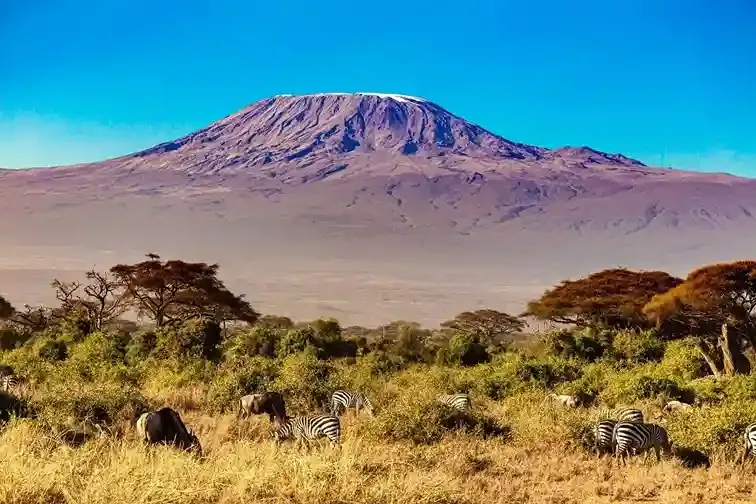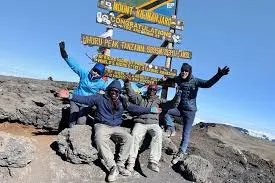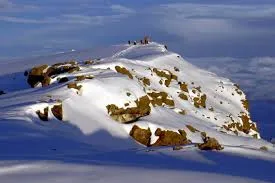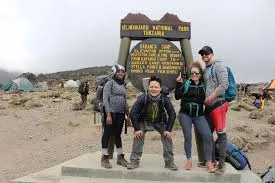Why Is Kilimanjaro Called the “Roof of Africa”?
Mount Kilimanjaro, towering at 5,895 meters (19,341 feet), earns its title as the “Roof of Africa” as the continent’s highest peak. With Capable Africa Tours, explore why this iconic mountain captivates adventurers worldwide. From its geological marvels to diverse climbing routes, cultural significance, and breathtaking views from Uhuru Peak, discover what makes Kilimanjaro a bucket-list trek. Ready to conquer the Roof of Africa? Let’s dive into its story and plan your adventure!
Plan Your Kilimanjaro Trek Now
The Height That Defines the “Roof of Africa”
At 5,895 meters (19,341 feet), Mount Kilimanjaro stands as Africa’s tallest mountain, dwarfing other peaks like Mount Kenya (5,199 meters) and Mount Meru (4,562 meters). Its summit, Uhuru Peak, is the highest point on the continent, offering panoramic views across Tanzania and beyond. This staggering elevation, combined with its accessibility as a non-technical climb, makes Kilimanjaro a magnet for adventurers. Capable Africa Tours ensures a safe, guided ascent to this iconic summit, blending expert support with eco-conscious practices.
Comparative Heights of Major African Peaks
| Mountain | Height (meters) | Height (feet) | Location |
|---|---|---|---|
| Mount Kilimanjaro | 5,895 | 19,341 | Tanzania |
| Mount Kenya | 5,199 | 17,057 | Kenya |
| Mount Meru | 4,562 | 14,967 | Tanzania |
| Ras Dashen | 4,550 | 14,928 | Ethiopia |
Geological and Historical Significance
Kilimanjaro’s title as the “Roof of Africa” isn’t just about height—it’s a geological marvel. Formed over a million years ago, this dormant stratovolcano comprises three cones: Kibo (the highest), Mawenzi, and Shira. Its prominence as a free-standing mountain, rising dramatically from the Tanzanian plains, adds to its allure. Historically, Kilimanjaro has been a beacon for explorers since its first recorded summit in 1889 by Hans Meyer and Ludwig Purtscheller. Local Chagga communities revere it as a sacred site, calling it “Kilema Kyaro” (difficult journey). Capable Africa Tours honors this heritage, integrating cultural insights into your trek.
Key Geological Facts
- Type: Dormant stratovolcano with three cones (Kibo, Mawenzi, Shira).
- Age: Over 1 million years old, formed by tectonic activity.
- Glaciers: Kibo’s summit hosts shrinking glaciers, a rare equatorial feature.
- Ecosystems: Spans five climate zones (rainforest, heath, moorland, alpine desert, arctic).
Why Kilimanjaro’s Routes Make It Special
Kilimanjaro’s seven climbing routes—Marangu, Machame, Lemosho, Rongai, Umbwe, Northern Circuit, and Shira—offer diverse paths to Uhuru Peak, each contributing to its “Roof of Africa” status. Routes vary in duration (5–9 days), scenery, and difficulty, catering to beginners and seasoned trekkers. Capable Africa Tours recommends the Lemosho Route (7–8 days) for its scenic diversity and 85–90% summit success rate, thanks to gradual acclimatization.
Comparison of Kilimanjaro Routes
| Route | Duration | Distance (km) | Success Rate | Features |
|---|---|---|---|---|
| Lemosho | 7–8 days | 70 | 85–90% | Scenic, less crowded, great acclimatization |
| Machame | 6–7 days | 62 | 80–85% | Popular, diverse landscapes |
| Marangu | 5–6 days | 72 | 65–70% | Hut-based, beginner-friendly |
| Rongai | 6–7 days | 73 | 80–85% | Remote, northern approach |
| Northern Circuit | 8–9 days | 98 | 90–95% | Longest, best acclimatization |
Experience Kilimanjaro’s Majesty
Watch this video to see why Kilimanjaro is called the “Roof of Africa.” Join Capable Africa Tours to explore its stunning landscapes, from lush rainforests to icy glaciers, on a guided trek to Uhuru Peak.
Preparing to Climb the Roof of Africa
Climbing Kilimanjaro requires physical and mental preparation to tackle its altitude and long hiking days. Capable Africa Tours provides tailored training plans, focusing on cardio, strength, and altitude acclimatization. No technical climbing skills are needed, making Kilimanjaro accessible to fit beginners. Pack smart with layers, waterproof gear, and a reliable daypack—Capable Africa Tours offers gear rentals for convenience.
Training Tips for Kilimanjaro
- Cardio: Run, cycle, or swim 4–5 times weekly for 45–60 minutes.
- Strength: Focus on squats, lunges, and core exercises for steep terrain.
- Hiking Practice: Train with a 5–7 kg pack on hilly trails (4–6 hours).
- Altitude Prep: Hike above 2,500 meters or use altitude simulation if possible.
- Mental Prep: Practice pacing and stay hydrated to build resilience.
Essential Gear Checklist
- Clothing: Moisture-wicking base layers, fleece mid-layers, Gore-Tex jacket/pants, down jacket for summit.
- Footwear: Waterproof hiking boots, 3–4 pairs merino wool socks, gaiters.
- Accessories: UV400 sunglasses, SPF 50+ sunscreen, trekking poles, headlamp.
- Other: 30–40L daypack, 3L water bladder, sleeping bag (-15°C rating).
Best Time to Climb Kilimanjaro
The best months to climb Kilimanjaro are January–March and June–October, when dry weather ensures clear skies and safer trails. Capable Africa Tours schedules treks during these seasons for optimal summit success. Avoid April–May and November due to heavy rains and muddy conditions.
Seasonal Weather Overview
| Season | Months | Weather | Pros | Cons |
|---|---|---|---|---|
| Dry (Peak) | Jan–Mar, Jun–Oct | Clear, 0–80°F | Best views, stable trails | Higher crowds |
| Wet | Apr–May, Nov | Rainy, muddy | Fewer trekkers | Poor visibility, slippery |
| Shoulder | Dec, early Jun | Mixed, light rain | Moderate crowds | Unpredictable weather |
Cultural and Environmental Impact
Kilimanjaro is more than a mountain—it’s a cultural and environmental treasure. The Chagga people view it as sacred, with folklore woven into its slopes. Capable Africa Tours supports local communities through fair wages for porters and eco-friendly practices, like waste management and sustainable trekking. The mountain’s glaciers, though receding, highlight the urgency of conservation efforts.
Conservation Efforts
- Eco-Friendly Treks: Capable Africa Tours follows “Leave No Trace” principles.
- Community Support: Fair wages for 3–4 porters per trekker, supporting local economies.
- Glacier Monitoring: Collaborations with park authorities to track environmental changes.
Climb the Roof of Africa with Capable Africa Tours
Ready to summit Kilimanjaro, the “Roof of Africa”? Capable Africa Tours offers all-inclusive packages with expert guides, eco-conscious practices, and a 90% summit success rate on longer routes. Book now for an unforgettable adventure to Uhuru Peak!
- High summit success rates (up to 90% on 8-day routes)
- Experienced guides and porters for safety and support
- Eco-friendly treks supporting local communities
- Gear rentals for hassle-free preparation
- Customizable itineraries for all fitness levels
Limited spots for Kilimanjaro treks—book now to conquer the Roof of Africa!
Plan Your Trek Now


